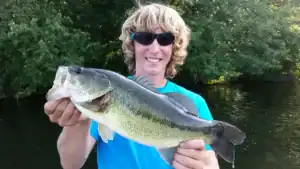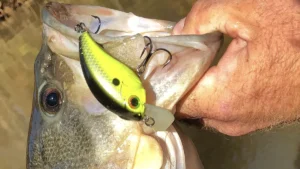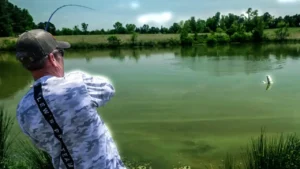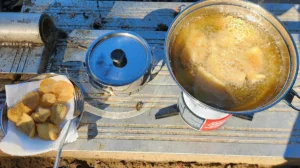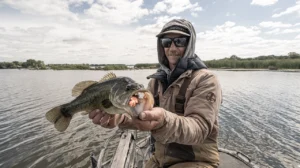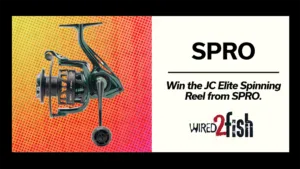I prepared fresh-caught fish into a delicious shore lunch using only supplies that fit inside a fishing backpack. You can too! This method works well for solo fishing trips.
First, I packed cooking essentials before the trip. This included utensils, a burner, fuel, a mess kit, frying oil, canned sides, dry goods, and seasonings. I also brought Ziploc bags, paper towels, and shopping bags for prep and cleanup. My most essential gear was a good fillet knife and cutting board. All cooking and fishing supplies easily fit into my 15L YETI Cayo backpack. With all essentials loaded, it was time to fish. On this trip, I landed several bluegill—a plentiful panfish across most states great for frying. My local honeyhole produced, providing enough big bluegill for a meal.
Prepping the Catch

With the catching complete, I filleted the bluegill. First, I bled them quickly with a knife stick under the gills, then let them drain in a bucket (exsanguinate). This ensured cleaner processing and better meat quality.
Next, I simply filleted the bluegill whole, skipping the gutting process common for other fish. I worked the knife down the back, along the spine, and over the ribcage. Afterward I removed both sides, then skinned the fillets.
I placed the skinned fillets into one Ziploc bag and set up my “outdoor kitchen.” I used an old dock mooring spot as a flat surface, then assembled the camp stove and unpacked my mess kit.
Cooking the Side Dishes

Lunch focused on fried food. I prepped the potatoes first, as they needed the longest frying time. I chose canned sliced potatoes because they were shelf-stable in the pack.
I opened the can, drained the required amount of potatoes, and patted them dry on paper towels. I tested the oil with a small piece; it bubbled vigorously, indicating the correct temperature. I dropped in the potatoes and increased the stove heat more to maintain the high frying oil temperature.
While the potatoes fried, I trimmed and cleaned the bluegill fillets. They were skinned but still contained pinbones and some rib pieces. I removed the pin bones by cutting a thin strip along the fillet’s midline. With the fillets boneless, I cut them into nuggets.
I put the nuggets into the Ziploc bag, seasoned them with a quick shake, then added bread crumbs and shook the bag again to coat all the pieces. After preparing the fish, I opened a can of beans and placed them into a separate mess pot to warm, avoiding cooking directly in the can they came in.
Serving Lunch
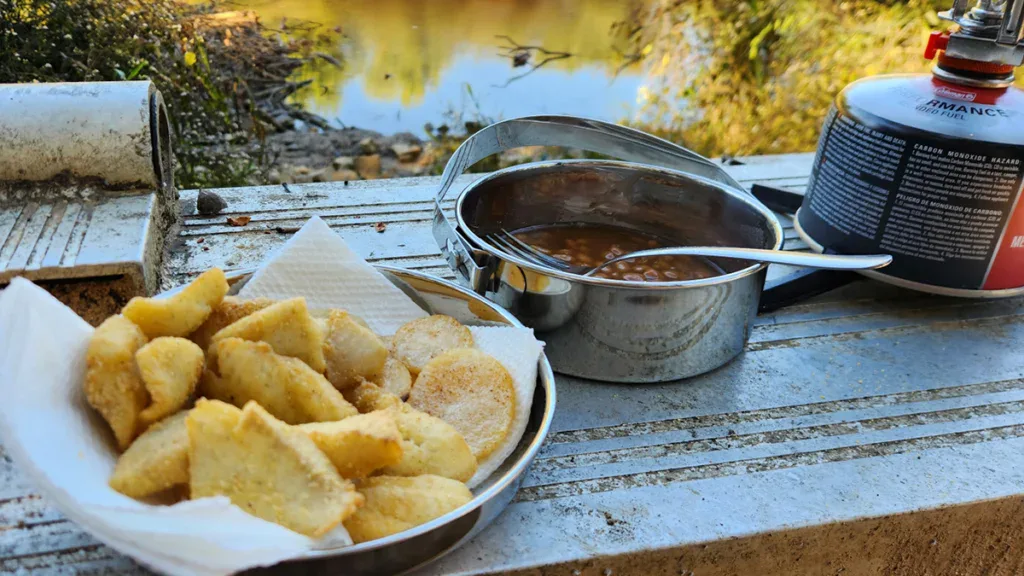
I checked the potatoes; they were now crispy. I scooped them out, drained the excess oil onto paper towels, and added a healthy dash of seasoning. With the potatoes done, I removed the frying pan and warmed those baked beans for a minute or two on the camp stove.
With the sides ready, I returned the frying pan to the stove and reheated the oil. I flicked a little breading into the oil to confirm it was bubbling. Once hot, I added the bluegill nuggets. I cooked the nuggets in batches to prevent the small pan’s oil from cooling, which can cause greasy food. I pulled the fried bluegill pieces out of the oil and placed them on paper towels to remove excess oil. Lunch was served, and it was delicious.
This shore lunch method worked well for day trip of bank fishing. It could be scaled up easily if I had been fishing from a boat or kayak. There’s so much much more storage on a vessel. Highlighting the steps I took to make an easy shore lunch is something you can easily imitate, or even expand on during your next on the water adventure. It truly doesn’t have to be a painful planning process to enjoy a meal of fresh fish outdoors.


